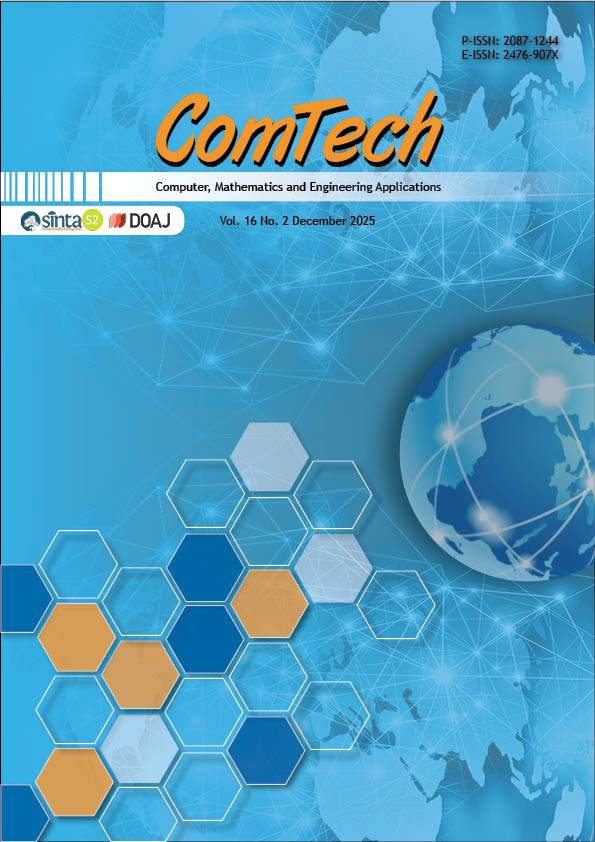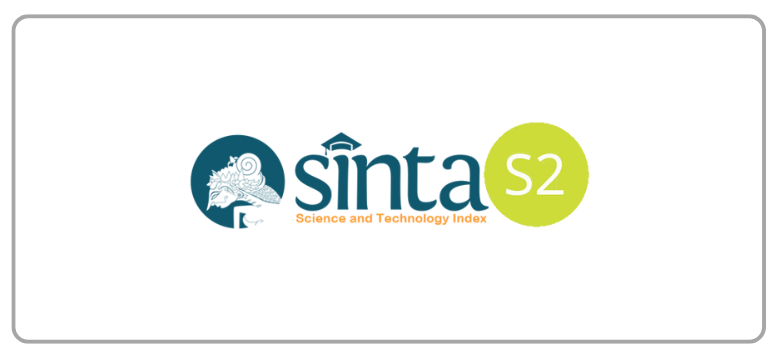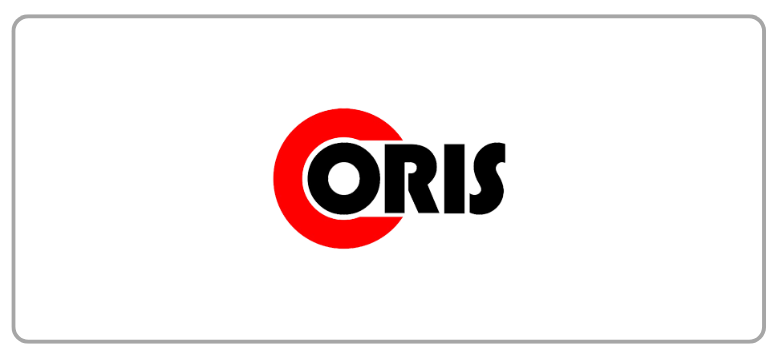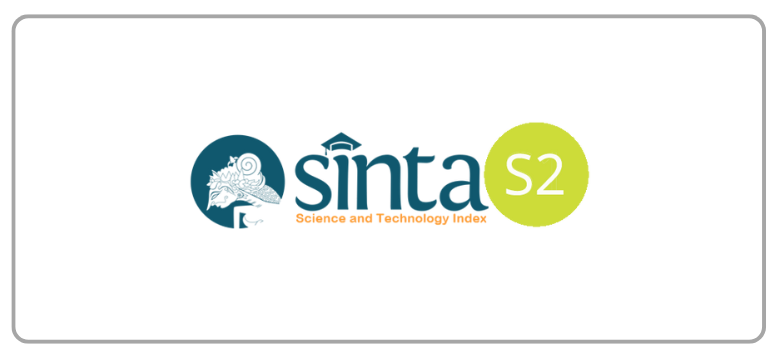Turning DIN 19682-7 Procedure of Infiltration Rate of Soils Test into the Mobile App for Cloud Storage
DOI:
https://doi.org/10.21512/comtech.v16i2.13000Keywords:
soil infiltration, mobile web application, Horton soil infiltration, DIN 19682-7, crowdsourching, cloud computingAbstract
The in-situ soil infiltration test using A Double Ring Infiltrometer (DRI) apparatus can be conducted in the field according to DIN 19682-7 standards and procedures. As required by these standards, the traditional paper-based measurement form can be replaced with a new application developed to meet standard requirements. The DRI apparatus consists of two concentric rings placed in the soil, filled with water, while the outer ring maintains a constant water level. The water level drop in the inner ring is observed and recorded at regular intervals. The infiltration rate can be calculated for each interval by measuring the change in water height over time. This new application facilitates the automatic calculation of both the actual soil infiltration rate and the Horton soil infiltration model. Comparison tests between the application results and Excel calculations have yielded similar outcomes. The goal of this research is to develop a mobile web-based application for recording data and calculating soil infiltration measurements using the DRI method. The research methodology involves transforming the measurement procedure into a concept, designing the application, and then implementing that design. By replacing the paper-based process, this application will enhance the efficiency, accuracy, and flexibility of soil infiltration measurement projects in various locations. Furthermore, the data will be stored in the cloud, allowing for crowdsourced infiltration data collection and monitoring from any location, including the office.
References
Abdelmoneim, A. A., Daccache, A., Khadra, R., Bhanot, M., & Dragonetti, G. (2021). Internet of Things (IoT) for double ring infiltrometer automation. Computers and Electronics in Agriculture, 188, 106324. https://doi.org/10.1016/J.COMPAG.2021.106324
Arienzo, M. M., Collins, M., & Jennings, K. S. (2021). Enhancing engagement of citizen scientists to monitor precipitation phase. Frontiers in Earth Science, 9, 617594. https://doi.org/10.3389/feart.2021.617594
Bandi, A., Adapa, P. V. S. R., & Kuchi, Y. E. V. P. K. (2023). The power of generative AI: A review of requirements, models, input–output formats, evaluation metrics, and challenges. Future Internet, 15(8), 260. https://doi.org/10.3390/FI15080260
Cao, J., Lam, K. Y., Lee, L. H., Liu, X., Hui, P., & Su, X. (2023). Mobile augmented reality: User interfaces, frameworks, and intelligence. ACM Computing Surveys, 55(9), 189.
Cleophas, F., Isidore, F., Musta, B., Mohd Ali, B. N., Mahali, M., Zahari, N. Z., & Bidin, K. (2022). Effect of soil physical properties on soil infiltration rates. Journal of Physics: Conference Series, 2314(1), 012020. https://doi.org/10.1088/1742-6596/2314/1/012020
DIN Media. (2015). DIN 19682-7 - 2015-08. https://www.dinmedia.de/en/standard/din-19682-7/236310867
Ding, W., Lin, X., & Zarro, M. (2025). Information architecture and UX design. Springer International Publishing AG. https://doi.org/10.1007/978-3-031-72138-0
Enríquez, J. G., Sánchez-Begines, J. M., Domínguez-Mayo, F. J., García-García, J. A., & Escalona, M. J. (2019). An approach to characterize and evaluate the quality of product lifecycle management software systems. Computer Standards & Interfaces, 61, 77–88. https://doi.org/10.1016/J.CSI.2018.05.003
Fraisl, D., Hager, G., Bedessem, B., Gold, M., Hsing, P. Y., Danielsen, F., Hitchcock, C. B., Hulbert, J. M., Piera, J., Spiers, H., Thiel, M., & Haklay, M. (2022). Citizen science in environmental and ecological sciences. Nature Reviews Methods Primers 2022, 2(1), 1–20. https://doi.org/10.1038/s43586-022-00144-4
Gorthi, S., Singh, R., Chakraborty, S., Li, B., & Weindorf, D. C. (2022). Identification of Köppen climate classification and major land resource area in the United States using a smartphone application. Geoderma Regional, 30, 567. https://doi.org/10.1016/j.geodrs.2022.e00567
Kouadio, J. S., Rodriguez, F., Grandvaux, E., & Waksberg, A. (2024). Pathway to design a multiparameter application for environmental monitoring to contribute to citizen well-being. Nature-Based Solutions, 5, 100117. https://doi.org/10.1016/J.NBSJ.2024.100117
Lala, S. K., Kumar, A., & Subbulakshmi, T. (2021). Secure web development using OWASP guidelines. Proceedings - 5th International Conference on Intelligent Computing and Control Systems, ICICCS 2021, 323–332. https://doi.org/10.1109/ICICCS51141.2021.9432179
Latorre, B., Moret-Fernández, D., Lyons, M. N., & Palacio, S. (2021). Smartphone-based tension disc infiltrometer for soil hydraulic characterisation. Journal of Hydrology, 600, 126551. https://doi.org/https://doi.org/10.1016/j.jhydrol.2021.126551
Lupián-Machuca, M. R., Cruz-Cárdenas, G., Flores-Magallón, R., Silva-García, J. T., Ochoa-Estrada, S., & Martínez-Trinidad, S. (2024). Prediction of water infiltration of three types of soil with machine learning in the Sahuayo River Basin. Applied and Environmental Soil Science, 2024(1), 5555105. https://doi.org/10.1155/2024/5555105
Maynard, J. J., Maniak, S., Hamrick, L., Peacock, G., McCord, S. E., & Herrick, J. E. (2022). LandPKS toolbox: Open-source mobile app tools for sustainable land management. Journal of Soil and Water Conservation, 77(6), 91A-97A.
Maynard, J. J., Yeboah, E., Owusu, S., Buenemann, M., Neff, J. C., & Herrick, J. E. (2023). Accuracy of regional-to-global soil maps for on-farm decision-making: Are soil maps "good enough''? SOIL, 9(1), 277–300. https://doi.org/10.5194/soil-9-277-2023
Nebe, K., & Heimgärtner, R. (2024). Ergonomic Principles in Designing Assistive Systems. In International Conference on Human-Computer Interaction (pp. 75-87). https://doi.org/10.1007/978-3-031-60875-9_6
Negreiros, B., Schwindt, S., Scolari, F., Barros, R., Galdos, A. A., Noack, M., Haun, S., & Wieprecht, S. (2023). A database application framework toward data-driven vertical connectivity analysis of rivers. Environmental Modelling & Software, 172, 105916. https://doi.org/10.1016/j.envsoft.2023.105916
Peng, S. (2024). The influence of graphical user interfaces on human-computer interaction and the impact of organizing software on decision-making process. Applied and Computational Engineering, 50(1), 213–221. https://doi.org/10.54254/2755-2721/50/20241509
Pudifoot, B., Cárdenas, M. L., Buytaert, W., Paul, J. D., Narraway, C. L., & Loiselle, S. (2021). When it rains, it pours: Integrating citizen science methods to understand resilience of urban green spaces. Frontiers in Water, 3, 654493. https://doi.org/10.3389/FRWA.2021.654493/BIBTEX
Rao, A. S., Radanovic, M., Liu, Y., Hu, S., Fang, Y., Khoshelham, K., Palaniswami, M., & Ngo, T. (2022). Real-time monitoring of construction sites: Sensors, methods, and applications. Automation in Construction, 136, 104099. https://doi.org/10.1016/J.AUTCON.2021.104099
Rao, H., Wang, J., Zhao, Z., Wu, G., & Feng, T. (2021). An analysis of rainfall infiltration of expansive soil slope based on the finite element software custom constitutive model. Hydrogeology and Engineering Geology, 48(1), 154–162. https://doi.org/10.16030/j.cnki.issn.1000-3665.202002020
Sergeeva, J., Filatova, A., Kovalchuk, M., & Teryoshkin, S. (2022). SemAGR: Semantic method for accurate geolocations reconstruction within extensive urban sites. Procedia Computer Science, 212, 409–417. https://doi.org/10.1016/J.PROCS.2022.11.025
Sulistyo, T., Achmad, K., & Purnama, I. B. I. (2022). The asset management and tracking system for Technical and Vocational Education and Training (TVET) institution based on ubiquitous computing. ComTech: Computer, Mathematics and Engineering Applications, 13(1), 23–34. https://doi.org/10.21512/COMTECH.V13I1.7342
Sulistyo, T., Achmad, K., & Respati, S. (2020). GeomatikaDroid: An Android application for improving theodolite measurement. Journal of Physics: Conference Series, 1450(1). https://doi.org/10.1088/1742-6596/1450/1/012021
Sulistyo, T., & Fauzi, R. (2023). Soil infiltration rate prediction using machine learning regression model: A case study on Sepinggan River Basin, Balikpapan, Indonesia. Indonesian Journal on Geoscience, 10(3), 335–347. https://doi.org/10.17014/IJOG.10.3.335-347
Sulistyo, T., Kusumayudha, S. B., Cahyadi, T. A., & Fajar, R. A. (2025). Mobile and web-based application as a tool for flood data collection based on citizen science. Earth Science Informatics 2024, 18(2), 1–14. https://doi.org/10.1007/S12145-024-01664-1
Sun, C., Tang, C. S., Vahedifard, F., Cheng, Q., Dong, A., Gao, T. F., & Shi, B. (2024). High-resolution monitoring of soil infiltration using distributed fiber optic. Journal of Hydrology, 640, 131691. https://doi.org/10.1016/J.JHYDROL.2024.131691
Thriemer, K., Ley, B., Ame, S. M., Puri, M. K., Hashim, R., Chang, N. Y., Salim, L. A., Ochiai, R. L., Wierzba, T. F., Clemens, J. D., Von Seidlein, L., Deen, J. L., Ali, S. M., & Ali, M. (2012). Replacing paper data collection forms with electronic data entry in the field: Findings from a study of community-acquired bloodstream infections in Pemba, Zanzibar. BMC Research Notes, 5(1), 1–7. https://doi.org/10.1186/1756-0500-5-113/TABLES/2
Uradziński, M., & Bakuła, M. (2020). Assessment of static positioning accuracy using low-cost smartphone GPS devices for geodetic survey points’ determination and monitoring. Applied Sciences, 10(15), 5308. https://doi.org/10.3390/APP10155308
Vandervaere, J.-P., Vauclin, M., & Elrick, D. E. (2000). Transient flow from tension Infiltrometers I. The two-parameter equation. Soil Science Society of America Journal, 64(4), 1263–1272. https://doi.org/10.2136/SSSAJ2000.6441263X
Viessman, W., & Lewis, G. L. (2011). Introduction to hydrology. Pearson Education.
Vishwakarma, D. K., Yadav, D., Kumar, R., Kumar, R., Bhat, S. A., Mirzania, E., & Kuriqi, A. (2024). Assessing the performance of various infiltration models to improve water management practices. Paddy and Water Environment, 1–17.
Whenua, M. (2019). Cloud-connected, smartphone-driven infiltrometer network. https://www.landcareresearch.co.nz/publications/soil-horizons/soil-horizons-articles/infiltrometer-network
Downloads
Published
How to Cite
Issue
Section
License
Copyright (c) 2025 Totok Sulistyo, Mariatul Kiptiah, Sari Bahagiarti Kusumayudha, Tedy Agung Cahyadi, Reza Adhi Fajar

This work is licensed under a Creative Commons Attribution-ShareAlike 4.0 International License.
Authors who publish with this journal agree to the following terms:
a. Authors retain copyright and grant the journal right of first publication with the work simultaneously licensed under a Creative Commons Attribution License - Share Alike that allows others to share the work with an acknowledgment of the work's authorship and initial publication in this journal.
b. Authors are able to enter into separate, additional contractual arrangements for the non-exclusive distribution of the journal's published version of the work (e.g., post it to an institutional repository or publish it in a book), with an acknowledgment of its initial publication in this journal.
c. Authors are permitted and encouraged to post their work online (e.g., in institutional repositories or on their website) prior to and during the submission process, as it can lead to productive exchanges, as well as earlier and greater citation of published work.
 USER RIGHTS
 All articles published Open Access will be immediately and permanently free for everyone to read and download. We are continuously working with our author communities to select the best choice of license options, currently being defined for this journal as follows:




















